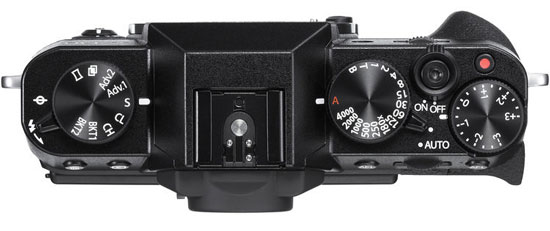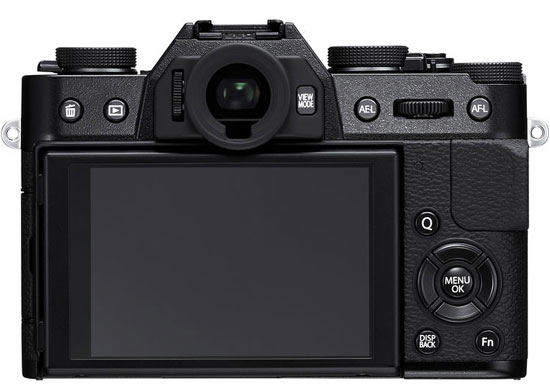Join More Than 50,000+ Subscribers and get latest camera news and rumors
NEW CAMERA VIDEOS ON YOUTUBE
|
By admin, on January 23rd, 2017
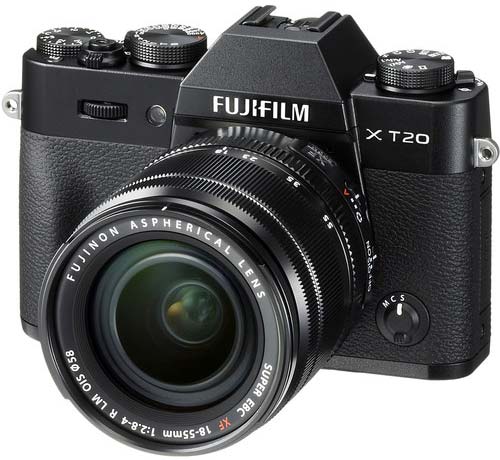
Fujifilm created a Dangal by announcing X-T20 camera a while ago. The X-T20 camera features new generation of sensor as well as image processor. Our specification comparison review Fuji X-T20 vs. X-T2 vs. X-T10 vs. X-T1 while give you a detailed look and analysis of features ..
Fuji X-T20 vs. X-T2
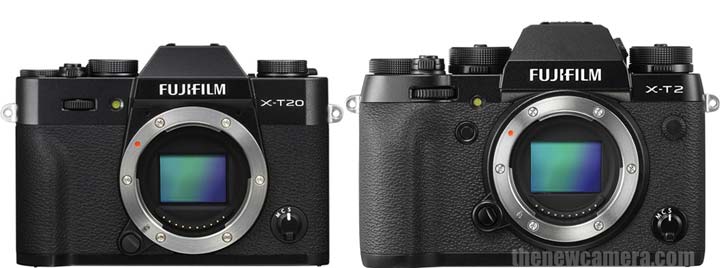
Technically the X-T20 carry same core specification as of the X-T2 camera and hence you will get same image quality from both the camera.
Why should you get Fuji X-T20 camera over the X-T2 ?
| Features / Models |
Fuji X-T20 |
Fuji X-T2 |
| Megapixel |
24 megapixels |
24 megapixels |
| Sensor size / type |
APS-C (23.6 x 15.6 mm) |
APS-C (23.6 x 15.6 mm) |
| Image processor |
X-Processor Pro2 |
X-Processor Pro |
| Low pass filter |
No |
No |
| Image stabilization |
No |
No |
| AF System |
Contrast detect + Phase detect |
Contrast detect + Phase detect |
| AF points |
325 points |
325 points |
| ISO |
100-51200 |
100-51200 |
| Shutter Min/Max |
60sec 1/4000 sec |
Shutter 30 seconds -1/8000 |
| Top Continuous Shooting Speed |
8/14 fps |
8/14 fps |
| Video |
4k @30fps |
4K @30fps |
| Display |
3.0 inch 1.04M-dot tilting TFT LCD Touchscreen |
3 inche 1.62 million dot LCD Monitor |
| Hot-shoe |
Yes |
Yes |
| Battery Life (CIPA) |
350 shots |
340 Shots |
| Wireless connectivity |
Built-In |
Wi-Fi, NFC |
| Weather Sealed |
No |
Yes |
| Dimensions |
118 x 83 x 41 mm |
139.0 x 105.2 x 78.5mm |
| Weight |
383 g |
650g |
More Frames, Better Display and More…
Fuji X-T2 features high resolution LCD screen and maximum shutter speed of Fuji film xt2 is also more compared to the X-T20 as well as the continuous shooting of X-T2 is approx 14 frames per second whereas the continuous shooting speed of the X-T20 camera remains limited to 8 frames per second only. The difference is very big if you are a sports shooter since you are losing 6 extra frames per second with the X-T20 camera.
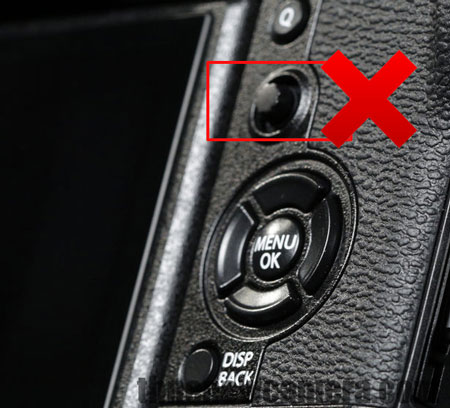
No Joystick in Fuji X-T20
Yes, the Fuji X-T20 camera doesn’t have Joystick like the X-T2 camera. So, this features doesn’t add a penny to image quality of the camera but it will sure help you to navigate your menus and select your desired AF points in a very easy manner.
Video
Well now let’s talk about the recording limit of both the camera. The recording time of both the camera is limited to 10 minutes in 4K mode, whereas if you use batter grip with your X-T2 it allow you to record 30 minutes video. If you select Full HD mode them both camera can record 15 minutes continues video.
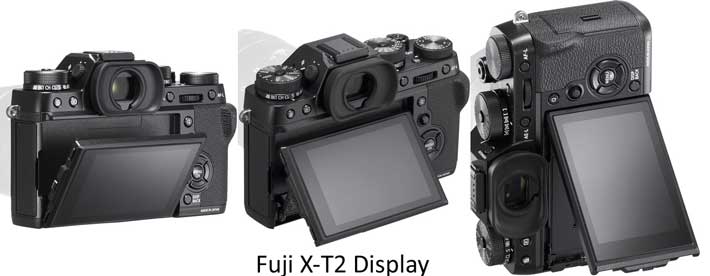
Display
Display of the camera are different and the major difference you will notice after getting in your hands is ouch sensitive display of the X-T2 camera and the X-T20 camera doesn’t have touch display.
Hence the Fuji X-T2 camera allow you to touch and shoot subjects on the go and helps you to navigate camera more quickly and easily compared to the X-T20 camera.
You Save $700
Yep, it’s a big plus point and with that money you can get a Fujinon 18-135mm f/3.5-5.6 ($699) – a perfect all rounder lens for your camera.
First and the biggest difference we notice is price. You get the X-T20 camera under $900 whereas you have to pay $1600 for the X-T2 camera. Despite of having such big difference in the price of both the camera you will get same image quality from both. camera features same sensor and image processor inside.
Verdict:
If you have pocket full of bucks then get X-T2 camera since it’s a marvelous machine, otherwise the trim-out version of the X-T2 / X-T20 will fullfill all your needs with bit of sacrifice in overall speed, Weather sealing and
Buy Fuji X-T20 from Amazon | B&H
Buy Fuji X-T2 from Amazon | B&H
Fuji X-T20 vs. Fuji X-T10
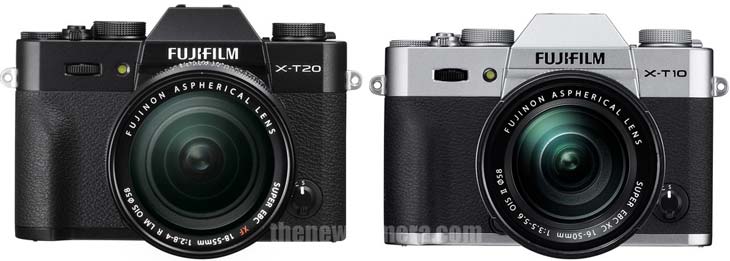
Lot of improvement done in X-T20 camera by Fujifilm, take a look at the detailed specification comparison review between these two camera
| Features / Models |
Fuji X-T20 |
Fuji X-T10 |
| Megapixel |
24 megapixels |
16.3 Megapixel |
| Sensor size / type |
APS-C (23.6 x 15.6 mm) |
APS-C (23.6 x 15.6 mm) |
| Image processor |
X-Processor Pro2 |
EXR Processor II |
| Low pass filter |
No |
No |
| Image stabilization |
No |
No |
| AF System |
Contrast detect + Phase detect |
Contrast + Phase detect sensor |
| AF points |
325 points |
77 Points |
| ISO |
100-51200 |
100-51200 |
| Shutter Min/Max |
60sec 1/32000 sec |
Shutter 60 seconds -1/32000 secs |
| Top Continuous Shooting Speed |
8fps |
8fps |
| Video |
4k @30fps |
1080p @60fps |
| Display |
3.0 inch 1.04M-dot tilting TFT LCD Touchscreen |
3.0″ 920k-Dot Tilting LCD Monitor |
| Hot-shoe |
Yes |
yes |
| Battery Life (CIPA) |
350 shots |
340 shots |
| Wireless connectivity |
Built-In |
Wi-Fi, NFC |
| Weather Sealed |
No |
No |
| Dimensions |
118 x 83 x 41 mm |
118 x 83 x 41 mm |
| Weight |
383 g |
381 g |
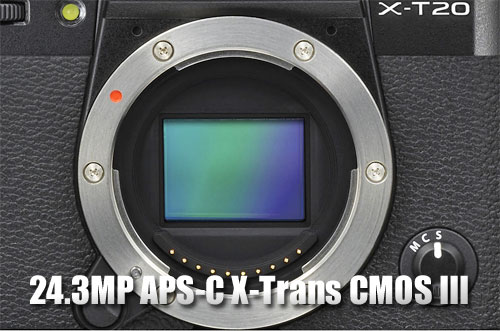
New Sensor
We have some major difference between the first and second generation of these cameras film X T20 camera features third generation of X-Trans CMOS sensor that features more AF points, resolution by maintaing the same ISO range.
With the help of new sensor you can select from 91 to 325 AF points. Hence you have approx entire area of the screen under AF. And hence you can spot and track your subject in no time.
With combination of latest XProcessor PRO camera the camera offers you continues shooting speed of 8 fps while using mechanical shutter and 14fps while using electronic shutter.
But, the top continues shooting speed of X-T10 camera remains limited to 8fps.
Extended Standard ISO Range
Fuji X-T10 camera standard ISO range is 200-6400 whereas the Fuji X-T20 features ISO range of 200-12800. The high ISO range of both the camera remains same.
Advance AF system:
By redesigning the AF algorithm from the ground up, the X-T20 can now autofocus more accurately on points of light, low-contrast objects and subjects with fine details such as bird feathers and animal fur. The read speed of the Contrast AF system, which covers approx. 85% of the entire frame, has been doubled*7 compared to the previous model to enable faster and more accurate autofocusing. During video recording, the AF point transitions smoothly to track a moving subject to create natural looking footage.
Shutter
The vertical grip of the X-T2 camera allow you to use mechanical shutter upto 11fps. Whereas there the X-T20 doesn’t have such facility. Despite of this slight difference the shutter speed of both the camera is almost identical 14fps with the electronic shutter or 8fps with the mechanical shutter.
4K video recording (4K vs Full HD)
The use of Fujifilm’s unique sensor and image processing engine enables both Full HD (1920 x 1080) and 4K (3840 x 2160) video recording. Set the Drive Dial to “Movie” and select the 4K Video mode in the menu to record 4K video at the high bitrate of 100Mbps. Full HD video can be recorded at 59.94 fps, 50 fps, 29.97 fps, 25 fps, 24 fps and 23.98 fps.
Verdict:
The Fuji X-T20 features a lot of big and small upgrades compared to the predecessor. Hence, we recommend you to get the Fuji X-T20 camera over X-T10.
Buy Fuji X-T20 from Amazon | B&H
Fuji X-T20 vs Fuji X-T1
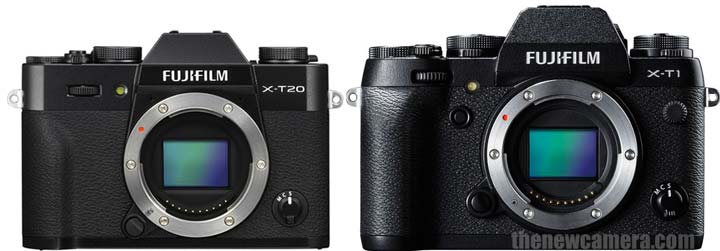
Undoubtedly the X-T1 was the flagship camera mirrorless camera a year ago but now the NEW Entry level X-T series camera is far better compared to that. let’s see the detailed specification for more details
| Features / Models |
Fuji X-T20 |
Fuji X-T1 |
| Megapixel |
24 megapixels |
16.3 Megapixel |
| Sensor size / type |
APS-C (23.6 x 15.6 mm) |
APS-C (23.6 x 15.6 mm) |
| Image processor |
X-Processor Pro2 |
EXR Processor II |
| Low pass filter |
No |
No |
| Image stabilization |
No |
No |
| AF System |
Contrast detect + Phase detect |
Contrast + Phase detect sensor |
| AF points |
325 points |
49 Points |
| ISO |
100-51200 |
100-51200 |
| Shutter Min/Max |
60sec 1/32000 sec |
Shutter 60 seconds -1/32000 secs |
| Top Continuous Shooting Speed |
8fps |
8fps |
| Video |
4k @30fps |
1080p @60fps |
| Display |
3.0 inch 1.04M-dot tilting TFT LCD Touchscreen |
3.0″ 1,040k-Dot Tilting LCD Monitor |
| Hot-shoe |
Yes |
Yes |
| Battery Life (CIPA) |
350 shots |
350 shots |
| Wireless connectivity |
Built-In |
Built-In |
| Weather Sealed |
No |
Yes |
| Dimensions |
118 x 83 x 41 mm |
118 x 83 x 41 mm |
| Weight |
383 g |
381 g |
New Sensor and AF System
We aren’t digging too much details here but as you know that the X-T1 uses IInd generation of X-trans sensor which features 16 MP resolution and only 49 AF points. Whereas, the III gen of X-Trans CMOS AF sensor carried a lot of design upgrades as well as new AF and image processing algorithm is implemented to outperform other flagship APS-C cameras of current generation.
The new sensor’s enhanced signal processing technology has even greater control over digital noise. Improved ISO sensitivity means ISO12800, only available as an extended ISO on the X-T10, is now available as a regular ISO option.
AF System
As we have already discussed that new sensor features more resolution and 325 AF points / you can select your AF points from 91 to 325 so you have a dense screen covered entirely with AF points. Whereas, the X-T1 limits itself with 49 AF points only.
4K Mode
The X-T20 is capable of recording both Full HD and 4K video using the X Series’ famous Film Simulation effects. Full HD video can be recorded at 59.94 fps, 50 fps, 29.97 fps, 25 fps, 24 fps and 23.98 fps. The X-T1 camera limited to Full HD videos at 60 FPS only.
ACROS mode
The Film Simulation function now features the ACROS mode. Using the X-Processor Pro’s advanced processing capability, the mode offers smooth gradation, deep blacks and beautiful textures to create monochrome images superior to the standard Monochrome mode.
Verdict:
We have seen a lot of upgrades in X-T20 camera, the X-T20 features new sensor and image processor and we are sure that the X-T20 camera is sully capable to give you BETTER IMAGE quality compared to X-T1. And hence, we recommend you to get the X-T20 camera over X-T1.
Buy Fuji X-T20 from Amazon | B&H
By admin, on November 8th, 2016
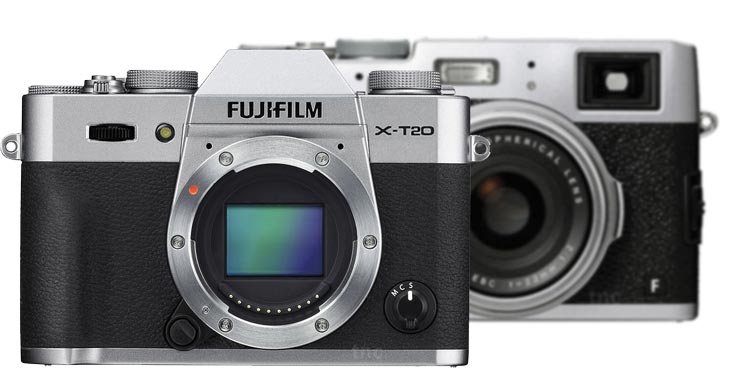
Fuji Registered a new pro compact camera at China MIIT and this could be the upcoming Fuji X-T20 or may be Fuji X100F. The Fuji X-20 rumor is not new and from past few months we have received several information from multiple websites that Fuji is ready to announce X100F as well as X-20 camera in Q1 or Q2 of 2017.
Details of the registered model
- FF160004
- CMIIT ID: 2016DJ6437
- Issue Date: October 19, 2016
- 2.4GHz Wi-Fi equipped
Take a look at the list of recently announced mirrorless camera and the code names.
Fujifilm code name
|
Product name |
| FF160001 |
X-T2 |
| FF160002 |
X-A3 |
| FF160003 |
X-A10 |
| FF160004 |
|
Along with Fuji Mirrorless camera Fuji also registered XP120 compact camera at MIIT take a look at the details of both the products below
- FinePix XP120
- CMIIT ID: 2016DJ6629
- Issue Date: October 24, 2016
- 2.4GHz Wi-Fi equipped
Stay with us and will update you soon as we get any new information.
Follow Dedicated Fuji Rumors Page on Facebook
STAY WITH ON FACEBOOK | TWITTER | GOOGLE+ to get live news + Fuji rumors 24X7
source nokishita
By admin, on September 26th, 2016
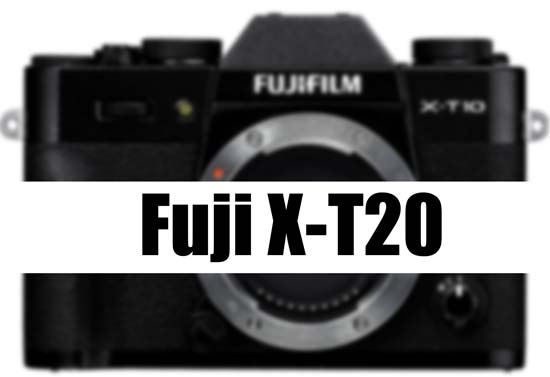
Fuji X-T10 was announced on May 18, 2015. The Fuji X-T10 was the trim-out version of X-T1 by having the same sensor and no extensive weather–sealing of the X–T1, the XT-1. If we believe recent rumors then The X-T10 production is now completely stopped and Fuji is waiting to clear the leftover stack of X-T10 camera.
The Fuji X-T20 announcement is expect sometime in 2017. Take a look at the announcement schedule XT series camera below:
| Model Name |
Date of Announcement |
| Fuji X-T1 |
January 28, 2014 |
| Fuji X-T10 |
May 18, 2015 |
| Fuji X-T2 |
July 7, 2016 |
| Fuji X-T20 |
2017 |
We have seen Fuji took 1+ year to release X-T1 camera. And I think Fuji will maintain the same time frame between these two models, early announcement of X-T20 will affect the sales number of X-T1 as well as X-Pro 2 since both camera shares same sensor.
Follow Fuji News and Rumors Page on Facebook for latest Updates
STAY WITH ON FACEBOOK | TWITTER | GOOGLE+ to get live news + Fuji rumors 24X7
By abhishek, on June 21st, 2015
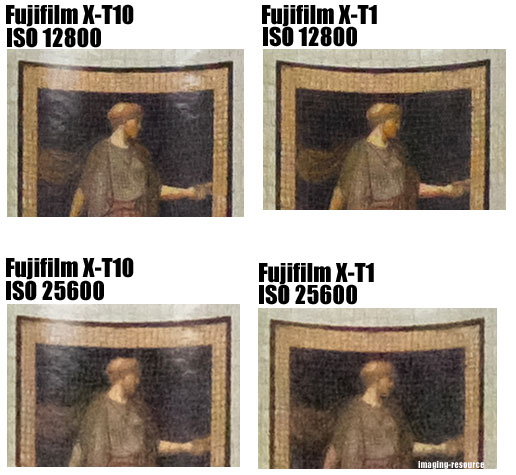 Take a look a the HIGH ISO test of both the camera, (ignore the glare due to bad lighting), at the end it is very clear that both camera is producing almost same image quality due to the presence of same image sensor inside it, however the XT-10 is an affordable version of the X-T1 camera and if you are planning to buy the X-T1 and don’t need weather sealing feature than you must buy the X-T10 and save some bucks for better lenses. Take a look a the HIGH ISO test of both the camera, (ignore the glare due to bad lighting), at the end it is very clear that both camera is producing almost same image quality due to the presence of same image sensor inside it, however the XT-10 is an affordable version of the X-T1 camera and if you are planning to buy the X-T1 and don’t need weather sealing feature than you must buy the X-T10 and save some bucks for better lenses.
Also see – Fuji Working on Medium Camera
STAY WITH ON FACEBOOK | TWITTER | GOOGLE+ to get live news + Fuji rumors 24X7
By abhishek, on May 22nd, 2015
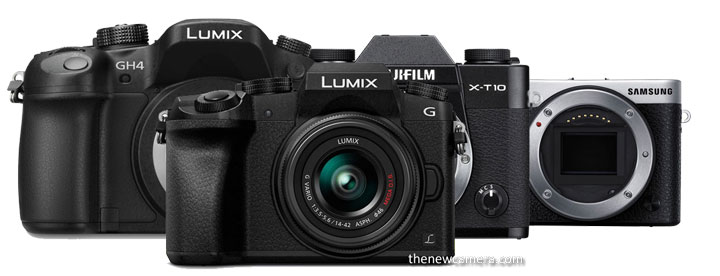 We have done a specification comparison review among the three entry level camera and one high-end camera, Jump to Verdict at the end for quick answer to your question… We have done a specification comparison review among the three entry level camera and one high-end camera, Jump to Verdict at the end for quick answer to your question…
The Panasonic G7 is just announced by the Panasonic, G7 is a entry level mirrorless camera with 4K video recording, the camera not only records 4K video but also captures 16 Megapixel Still from a 4/3 sensor.
However if we look at all the camera below in the table we can clearly see that the Samsung NX500 is a complete technology breakthrough if we compare its price with features…
Sensor – Panasonic cameras get a early defeat due to the small sensor size used inside the camera, now only two camera left with big sensor,.. the NX500 and X-T10.
As we know that bigger sensor captures more light, other major factor is number of pixels vs sensor size… if the pixel density is high than each pixels will get small fraction of light compared to sensor with larger pixels, the fujifilm X-T10 sensor is of same size as of the Samsung NX500 and due to less resolution the pixels are big and will capture more light compared to the Samsung NX500… hence FUji X-T10 will give you better low light performance compared to the Samsung NX 500.
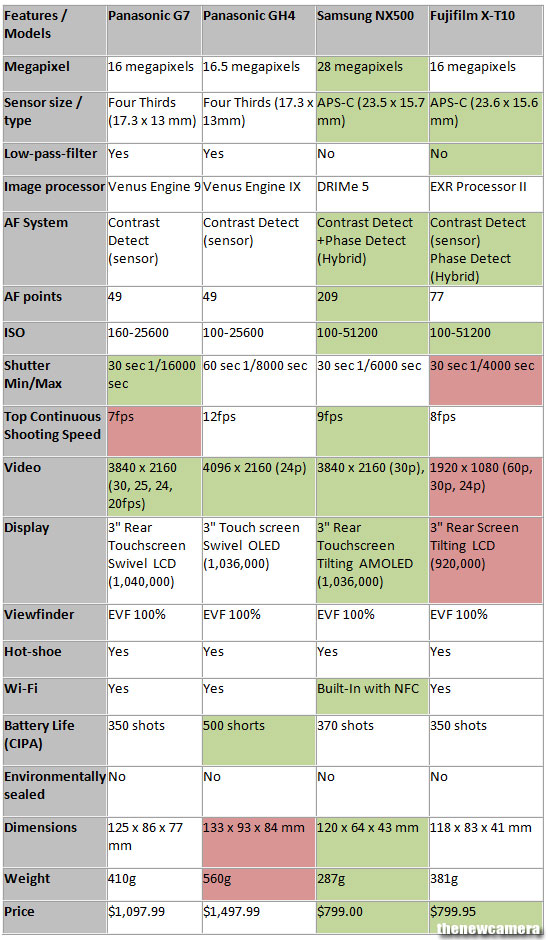
Advance AF system inside the Samsung and Fuji – Samsung NX500 and Fuji X-T10 both camera based on advance Hybrid CMOS AF sensor technology,
1. NX500 features a dense network of 209 active phase AF points inside the sensor.. not only that thanks to the ultra fast image processor the camera can do shoot 9frames per second @ 28 Megapixels…
“High-speed shooting at up to 9 fps is possible as well and the NX500 uses the NX Autofocus System III with 205 phase-detect points of which 153 are cross-type for fast, accurate focusing.”
2. X-T10 features X-trans sensor that also feature 77 active phase AF points inside the sensor… and captures
” Fujifilm’s unique X-Trans pixel array, the sensor is designed with a randomized pixel pattern to eliminate the need of an optical low-pass filter for reducing moiré and aliasing. By removing this filter from the design, higher image sharpness is possible. “
3. The Panasonic uses traditional contrast based Auto focus system.. but thanks to the new DFD system the AF system do work very well under any light condition…
The high-precision Contrast AF integrates DFD (Depth from Defocus) technology to achieve AF speeds of approximately 0.07 sec in AFS mode.
High ISO Performance
As we have said earlier … The camera sensor size is very important when low-light performance matters, the bigger the sensor will capture more low-light compared to the smaller ones…
Panasonic G7 and Panasonic GH4 sensor size is limited (17.13mm) and the ISO range is limited upto 25600, on the other hand the Samsung NX500 and Fujifilm XT-10 both features APS-C sensor and ISO range upto 51200.
Despite of having such a High ISO range we won’t get better performance from Samsung NX500 since the size of the pixels are smaller compared to the X-T1 camera… so if you are a low light lover you mist go with the X-T10 camera.
Shutter:
Both Panasonic G7 and GH4 features electronic and mechanical shutter..The widest shutter range is of Panasonic G7. Both camera have silent shutter feature inside, when you select silent shutter mode the cameras work in silent mode without making a noise.
Samsung NX500 and Fuji X-T10 also have electronic and mechanical shutter, but no silent shutter option available in the Samsung NX500 as of Panasic GH4 and G7.
Video: Out of all these 4 mirrorless camera three of them shoot 4K videos, the Fuji X-T10 is only limited to Full HD video.
The Panasonic G7 records 4 K videos internally and G7 supports 4K UHD (3840 x 2160) video with either 30p or 24p frames rates at 100Mbps in the MP4 format.
The DMC-GH4 brings the GH-line into the 4K age by offering both 16:9 UHD 4K 3840×2160 video at 23.98p, 24p or 29.97p, and 17:9 DCI (Digital Cinema Initiatives) 4K 4096×2160 videos at 24p.
Samsung NX500 can record 4K video @ 24p, Ultra-HD, at 30p, as well as in full HD up to 60p.
Fuji X-T10 supports Full HD 1080p video recording is supported up to 60 fps,No 4K available.
Display: The Samsung NX500 features 180° tilt capability of the 3.0″ 1036k-dot touchscreen AMOLED monitor one of the best display available in the market. Both Panasonic cameras also features better display unit but Fuji X-T10 screen is bit inferior to all.
Connectivity: The Most advance camera in terms of connectivity is Samsung NX500, the camera can share the files wirelessly with any device and you can use any NFC enabled device to control you camera from distance. The Panasonic G7 also features built-in Wi-Fi connectivity for wirelessly sharing images and remotely controlling the camera from a linked mobile device using the Panasonic Image App.
Verdict (Price vs. Features)
If we compare list of features available vs price of the camera than Samsung NX500 is a clear winner, the camera features a super resolution HYBRID CMOS AF sensor, no optical low pass filter and ultra high speed image processor can capture 28 MP still shots @ 9 frames per second, the samsung NX500 mirrorless is smallest among all and easy to carry, we highly recommend you to go with the Samsung NX500 camera.
Buy Samsung NX500 from Amazon | B&H
By admin, on May 20th, 2015
Fuji X-T10 Sample images are now floating on web, however looking at the images we don’t see any difference since it features same sensor as of the X-T1
 Continue reading Fuji X-T10 Sample Image Continue reading Fuji X-T10 Sample Image
By admin, on May 18th, 2015
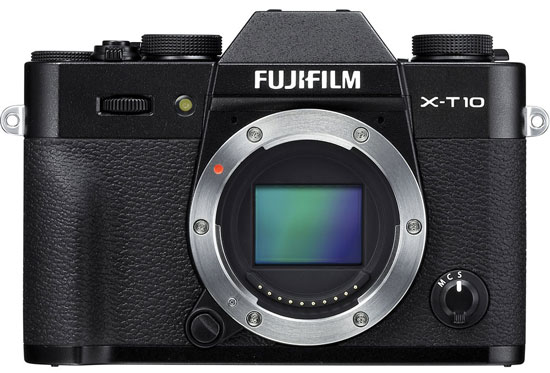
Fujifilm X-T10 finally announced by Fuji today, the camera is said to be a carbon copy of Fuji X-T1 from inside… same sensor, image processor…etc take a look at the major specification..
- 16.3 MP APS-C X-Trans CMOS II Sensor
- EXR Processor II
- 0.39″ 2,360k-Dot 0.62x OLED Viewfinder
- 3.0″ 920k-Dot Tilting LCD Monitor
- Full HD 1080p Video Recording at 60 fps
- Built-In Wi-Fi Connectivity
- Intelligent Hybrid AF with 77 Areas
- Up to 8 fps Shooting and ISO 51200
- Film Simulation Mode, Electronic Shutter
- Built-In Pop-Up Flash
the Fuj X-T10 doesn’t have weather sealed body as of the X-T1 camera and that saves a lot of bucks ($799 vs $1299) when you compare the price of the X-T10 camera from X-T1.
Fujifilm X-T10 Full Specification
Press Release
FUJIFILM ANNOUNCES LIGHTWEIGHT X-T10 – THE INTERCHANGEABLE LENS CAMERA THAT DELIVERS PROFESSIONAL QUALITY RESULTS FROM DAY ONE
X-T10 uses advanced scene recognition and new auto focus system to capture your memorable moments
Valhalla, N.Y., May 18, 2015 – FUJIFILM North America Corporation today announced the all new FUJIFILM X-T10, the latest premium interchangeable lens camera that joins the world-renowned X-Series digital camera line-up. The sleek FUJIFILM X-T10 delivers outstanding image quality, usability and portability for photo enthusiasts with its new innovative autofocus system, large electronic Real Time Viewfinder, and incredible continuous shooting speed of up to 8.0fps. The X-T10 also has an amazingly short lag time of just 0.005 seconds so users can be ready and capture every image imaginable.
The FUJIFILM X-T10 uses the latest generation 16.3 Megapixel APS-C X-Trans CMOS II sensor with built-in phase detection autofocus along with the high-performance EXR Processor II, and is compatible with all FUJINON lenses to deliver excellent resolution and outstanding image quality.
Advanced new autofocus system
The FUJIFILM X-T10 uses a new auto focus system that complements the fast and accurate single-point auto focus system with new Zone and Wide/Tracking modes, which use 77 autofocus points across a wider area to substantially improve the camera’s ability to track and capture moving subjects.
The Zone mode allows users to choose a 3×3, 3×5 or 5×5 zone from the 77-point auto focus area. When combined with the AF-C continuous focusing mode, the camera continues tracking a subject in the selected zone. The 3×3 and 3×5 zones at the center, in particular, offer extra-fast focusing with the use of the built-in phase detection pixels.
In the Wide/Tracking mode, the camera displays the area in focus, identified automatically out of the 77-point auto focus area (Wide in the AF-S mode) and tracks the focus area’s subject across the entire 77-point AF area (Tracking in the AF-C mode). This makes it possible to maintain focus on a subject that moves vertically, horizontally, and back and forth.
Stunning design with functional control
The FUJIFILM X-T10 has an all-new design that packs the best X-Series functionality into a compact and lightweight body, perfect for travelling light. The X-T10 top and base plates are made of a lightweight, but highly rigid, die-cast magnesium. The top plate features three precision-milled aluminum dials that give the X-T10 a premium feel and allow users to intuitively adjust the combination of aperture, shutter speed and shooting functions while concentrating on picture taking.
The X-T10’s back panel has a 3” 920K-dot tilting LCD monitor that makes above head and close to the ground shooting easy and fun. The X-T10 also has a new Auto Mode Switch lever for selecting the fully-automatic Advanced SR Auto mode. In this mode, the camera automatically chooses optimum settings for a given scene to make shooting effortless.
The X-T10 body also features an integrated pop-up flash, positioned in the center of the top plate that uses Super Intelligent Flash to automatically adjust light output according to the scene type.
A FUJINON XF/XC lens for every shooting style
The FUJIFILM X-T10 is compatible with every current FUJINON lens – 18 premium lenses ranging from ultra-wide-angle to telephoto, including five fast aperture prime lenses. These lenses bring out the very best image quality from the X-T10. Together with optional accessories including X- mount adapters and macro extension tubes, users can experience a full range of photographic possibilities with images that achieve edge-to-edge definition for high-resolution pictures across the entire frame.
FUJIFILM X-T10 key features:
- 16.3 million Megapixels APS-C X-Trans CMOS II Sensor
– EXR Processor II
– Fast AF of 0.06 seconds
– Startup time of 0.5 seconds
– Shutter time lag of 0.005 seconds
– Shooting interval of 0.5 seconds
- High-precision 2.36 million dot OLED viewfinder
- Large viewfinder magnification for digital cameras of 0.62x
- Wide viewing angle (horizontal 25°)
- Ultra-fast Real Time Viewfinder with a lag-time of 0.005 second and new Natural Live View with Preview Picture Effect
- Tempered glass 920K-dot high-precision 3” tilting LCD monitor
- Digital Split Image and Focus Highlight Peaking
- Completely electronic shutter up to 1/32000 seconds
- ISO200 – 6400, extended ISO 100, 12800, 25600, Auto (maximum ISO setting from ISO 400 – ISO6400 available)
- ISO setting of up to 51200 for ultra-high sensitivity that produces low noise and strong blacks in low light conditions.
- ‘Classic Chrome’ and ten other film simulation modes with eight Advanced Filter functions
- Eye Detection AF to automatically detect and focus on human eyes
- Full HD video 1080p at 60fps; bit rate of 36Mbps for clear capture of delicate movements; frame rates of 50fps, 30fps, 25fps and 24fps, supporting worldwide motion picture formats with a high bit rate of 36Mbps for high definition video capture
- Manual focus available during video recording
- Auto Macro function automatically activates the Macro mode while maintaining AF speed
- Variable aspect ratio can be selected from 3:2, 16:9, and 1:1 (square) to accommodate a wide range of photographic styles
- Interval timer shooting for time lapse photography is available with intervals of one second to 24 hours and up to 999 frames.
- Free FUJIFILM Camera Remote application and Wireless Communication function allows users to remotely shoot images from smartphones and tablets via WiFi
- Photos can be sent to the INSTAX Share Printer using the free INSTAX Share App (iOS and Android) SHARE Smartphone Printer.
The FUJIFILM X-T10 will be available in June 2015 in the following configurations:
X-T10 Body – USD $799.95 USD \ CAD $899.99.
X-T10 XC16-50mm Kit – USD $899.95 \ CAD $999.99.
X-T10 XF18-55mm Kit – USD $1,099.95 \ CAD $1,249.99.
|
KEEP THIS BLOG ALIVE - Support New Camera Buy Canon Lenses, Buy Music CD or Digital Camera at amazon it helps this site, and you do not pay anything extra, it is just a way to help support this site.

|















